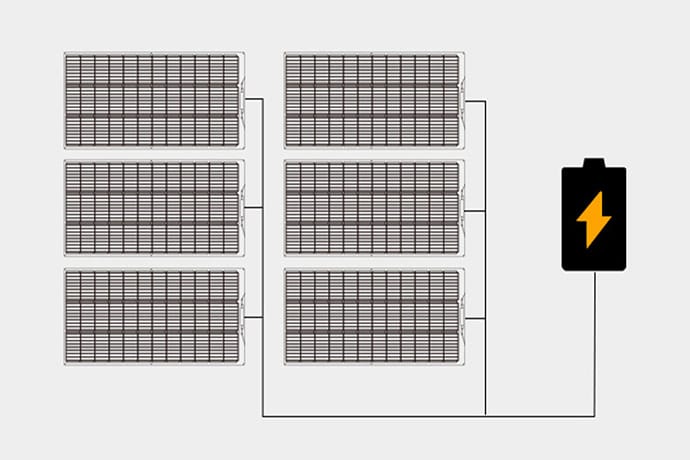When installing solar panels in an RV, it is necessary to consider the energy requirements of the RV, the specifications of the solar panels, and the installation space in order to determine the number of solar panels required and the series-parallel connection method.
Series connection is suitable for the situation where the system voltage needs to be increased. By connecting the solar panels in series one by one, the required voltage output can be achieved.
A parallel connection, on the other hand, is suitable for situations where the current output of the system needs to be increased, and by connecting the positive and negative poles of the solar panels together separately, the overall current output can be increased.
How many solar panels do I need to connect in series and parallel in my RV?
Determining how many solar panels need to be installed in an RV and how to do solar panels series vs parallel requires the following considerations:
Energy Requirements: The first step is to determine the equipment that needs to be powered in the RV and its energy consumption. This can be determined by assessing the power of the electrical equipment used in the caravan and the hours of use per day.
Solar panel specification: Select the appropriate solar panel specification based on the energy requirements of the caravan and the available installation space. Considering the space constraints and weight load of the RV, lightweight and efficient flexible solar panels are usually selected.
System Voltage and Current: Based on the design of the RV solar system, determine the voltage and current requirements of the system. This will affect how the solar panels are connected in series and parallel.
Charge Controller and Battery Capacity: Determine the number of solar panels required, taking into account the capacity of the charge controller and battery, as well as the charging efficiency of the solar panels.
Installation space and layout: Determine the location and layout of the solar panels, taking into account the external space and shape of the caravan. Avoid shading and shadows, and make sure the solar panels can receive full sunlight.
Generally speaking, based on the above factors, the following rough estimation and installation plan can be made:
Energy demand assessment: Assume that the total power of the equipment to be powered in the caravan is 500W, and the daily usage time is 8 hours. Then the total daily consumption of 500W * 8h = 4000Wh of electricity.
Selection of solar panel specifications: Assuming that the rated power of each flexible solar panel is 100W and the operating voltage is 18V, each solar panel can generate 100W * 8h = 800Wh of electricity per day.
Determine the number of solar panels: According to the energy demand and the daily power generation of each solar panel, the number of solar panels required can be calculated as 4000Wh / 800Wh/block = 5 solar panels.
Series-parallel connection: According to the voltage and current requirements of the caravan solar system, choose the appropriate series-parallel connection. If the system voltage is low, consider series connection to achieve the required voltage. If the system voltage is high, consider a parallel connection to increase the current output.

RV Solar Panel Series and Parallel Solutions
The following are specific examples and solutions for different situations:
1. RV system with low voltage
If the solar system voltage of the RV is low, such as a 12V system, a common way to connect the solar panels in series to reach the required voltage of the system, and then connect the combined panels in parallel after the series connection to increase the current output.
Suppose the output voltage of each solar panel is 18V and the current is 5A.
If the system requires a voltage of 12V, two solar panels can be connected in series to get an output voltage of 18V.
If the current output needs to be increased, another two solar panels can be connected in series and then the two sets of series panels can be connected in parallel to increase the overall current output.
In this way, it is realized that both the voltage requirements of the system can be met and the overall current output can be increased.
2. RV or marine system with high voltage
In the case of RV or marine solar systems with high voltages, such as 24V or higher, a parallel connection can be used to meet the system voltage requirements.
Assume that each solar panel has an output voltage of 18V and a current of 5A.
If the system requires a voltage of 24V, each solar panel can be connected in parallel to keep the output voltage constant but increase the overall current output.
If the overall current output needs to be increased further, consider installing more solar panels and connecting them all in parallel.
3. Consider the impact of different installation scenarios
In a practical installation, the layout of the RV or boat, the available mounting space, and factors affecting the shading of the solar panels need to be considered. These factors may affect the way the solar panels are arranged and the exact realization of the series-parallel connection.
Example:
If installation space is limited or shading is an issue, you may choose to install the solar panels in separate series and parallel to minimize the impact of shading on the overall system.
In addition, it is important to ensure that the connections between solar panels are reliable and durable, and to select high-quality connectors and cables to improve the stability and durability of the system.
In summary, the series-parallel connection method for RV or marine solar systems needs to be designed according to specific system voltage requirements and installation scenarios to ensure that the system can work stably and efficiently.

























